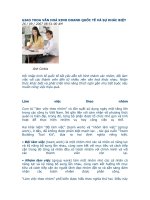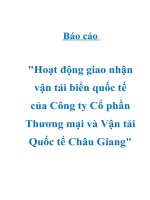Tài liệu Assignment on intercultural communication giao thoa văn hoá-Download
Bạn đang xem bản rút gọn của tài liệu. Xem và tải ngay bản đầy đủ của tài liệu tại đây (420.67 KB, 12 trang )
MINISTRY OF EDUCATION AND TRAINING
HANOI OPEN UNIVERSITY
FACULTY OF ENGLISH
ASSIGNMENT ON INTERCULTURAL COMMUNICATION
COMPARISION ENGLISH GREETINGS AND VIETNAMESE
GREETINGS
(SO SÁNH LỜI CHÀO HỎI CỦA NGƯỜI ANH VÀ LỜI CHÀO HỎI CỦA
NGƯỜI VIỆT)
Supervisor: Nguyen Van A
Hanoi, 2017
0
CONTENTS
Contents…………………………………………………………………………………...1
I.
Introduction…………………………………………………………………....2
II.
Development………………………………………………………………...…3
1. Theory background……………….………………………………………............3
1.1. Definitions about “Greeting”……………………………………..................3
1.2. Greeting gestures…………………………………………………...……….4
2. Greetings in Vietnamese and in English………………………………………....4
2.1. Greetings in English…………………………………………………...……4
2.1.1. Greeting expressions………………………………………………….…4
2.1.2. Greeting gestures…………………………………………..……………5
2.1.3. Special greetings……………………………………………….………..5
2.2. Greetings in Vietnamese………………………………………………..…..5
2.2.1. Greeting expressions……………………………………………………6
2.2.2. Greeting gestures………………………………………………………..6
2.2.3. Special greetings………………………………………………………...7
3. A comparison between English and Vietnamese greetings………………….…7
3.1. Similarities………………………………………………………………….8
3.1.1. Greeting expressions………...………………………………………….8
3.1.2. Greeting gestures………………………..………………………………8
3.2. Differences…………………………………………………...……………..8
3.2.1. Culture…………………………………………………………………..9
3.2.2. Religion………………………………………………………………….9
III.
Conclusion……………………………………………………………………10
REFERENCES…………………………………………………………………...….11
I.
Introduction
1
As we know there are many countries in the world. Each has own it culture. ‘’A
nation's culture resides in the hearts and in the soul of its people’’- Mahatma Gandhi. It is
true that knowing the culture of a country is, in effect, a guide to understanding the soul of
that country and its people. Culture refers to many factors such as art, music, food,
literature, etc. However, on the study, I would like to show my understanding about
greeting culture.
As an English learner, first of all, I learn greeting in English such as: “Hi”, “Hello”,
“Good morning”, etc, and learn how to use them. I find a lot of interesting points of
English culture in common , English greetings in particularly. Hence, on this paper, I
would like to show my understanding about English greetings. Specially, I will compare
and contrast it with Vietnamese greeting to show the differences and similarity between
greetings of two countries.
I hope that my study will help people who are interested in English culture, will have
more knowledge about English culture and intercultural communication of it with
Vietnamese culture.
II.
Development
1. Theory background.
1.1. Definitions about “Greeting”.
2
When you see a friend or someone you may probably say “Hi”, “Hello”,
“Good morning”, etc to them or you may wave or smile or maybe you do all
of them. These actions are called greetings.
Greetings are things people say or do to show that they recognize the presence
of the others. Greeting is an important communicative etiquette and it is a cultural
etiquette.
Because of differences in culture, language, every country has its own ways yo
form greetings.
For examples:
- “Good evening”, “Hello”, “What’s up!”, etc (in English)
- “Chào”, “Xin chào”, “Chào bác”, etc (in Vietnamese)
- “Konichiwa”, “Ohio”, etc (in Japan)
Perhaps, greeting is one of the most popular interactions among people.
Everyone in the world greets each other, every country has its own greeting
culture. Greeting is an important activity.
Firstly, it is clear that almost every human interaction begins with
greetings.
When meeting, people do not start talking directly, first of all they greet each
other then they talk about the topics. In other words, every communication begins
with greetings.
Greetings are not just sayings, gestures used to start the conservation, they also
conveys messages. People’s greetings can show the relationships among greeters.
A good greeting helps to maintain the conversation and leads the
communicators to take interest in talking to each other. Through greetings, you can
express your friendliness, respect, politeness, etc, or your friends by choosing
suitable greetings and intonation. That is the key for you and your friends to have
successful conversation.
The ways people greet (gestures or saying) can tell us information about
culture, customs, religion, etc.
Basing on greetings, we can also indicate something about the social status,
age-range of the greeters.
1.2. Greeting gestures
Greetings are not just words, sayings. Body language –the way people stand,
people look at the other’s faces, the movement you make during greeting process are
3
the greeting gestures. There are a lot of greeting gestures, and greeting gestures vary
from culture to culture. For example: Kissing, handshake, bow, waving, eyes contact,
…; greetings used in formal situations, greetings used in informal situations, special
greetings, religious greetings.
2. Greetings in Vietnamese and in English
2.1. Greetings in English
Like many countries in the world, England has the system of greeting including
greeting expressions and greeting gestures.
2.1.1. Greeting expressions
Direct greeting expressions:
In English, there are a number of direct greeting expressions, which contain verbs
of greeting like “greet”, “welcome”, greeting words like “Hello” , “Hi” , “Hey” , etc.
The interjections “hello, hi, hallo,” are often used in informal situations. They are
used commonly by young generation and among close friends, etc, and people who have
slight relationship with each other.
The greeting expressions which include the verbs of greeting like “greet”,
“welcome” are often used in writing, or informal situations.
For examples: I greet her by saying good morning (in writing) “Greetings Ladies
and Gentlemen!” Or “Ladies and Gentlemen!” (formal) Welcome to our Beauty contest.
(greeting of a speaker) Welcome to Hanoi city.
Indirect greeting expressions:
In English, there are a lot of indirect greeting expressions. There are some ways of
forming indirect greeting expressions. This kind of greeting in English is divided into two
groups basing on the linguistic forms. They are: “Good + part of the day” such as: “Good
morning” , “Good evening” , “Good afternoon” and “questions (usually open
questions)” such as: “How are you?”, “How do you do?” , “what’ s new?” , “what’ s
up?” , etc.
2.1.2. Greeting gestures
Whereas in many countries and in the European continent, handshaking is done when
meeting and departing day in and day out and even the same assortment of acquaintances,
in England as well as Great Britain, it is done less frequently. It is sometimes difficult to
know when to shake hands with English people in business situations, men always shake
hands when they first meet each other. Recently, especially in the business world, women
4
have begun to shake hands, too. And younger women shake hands more often than older
women do.
2.1.3. Special greetings
In English, there are not many special greetings their religion -Christianity- does not
affect their greeting much. On special days, they have special greetings for the days. On
the New Year days, they usually greet each other by saying “Happy new year” in the
birthday party, they say “Happy birthday” to that person. On the Christmas day, people
would say: “Merry Christmas”. These greetings function as a greeting, and a wish that
many good things come with you. These greetings are indirect greeting expressions.
In the old time, the Queen of England was greeted very formally by her subjects,
usually when someone greeted the Queen, he had to knee and kiss the Queen’s hand when
she offered her hand.
(The Queen was being greeted)
2.2.
Greetings in
Vietnamese
To
Vietnamese culture,
the greeting is
very important in
everyday
conversation, as
there is a saying
that: “A greeting is
more important
than a meal” (Lời
chào cao hơn mâm cỗ). As the Vietnamese have to greet people everywhere, every time
they meet. Therefore, there are a great number of greetings in Vietnamese and they can
also be divided into two main kinds: Greeting expressions and greeting gestures.
2.2.1. Greeting expressions
As Vietnamese greet each other usually, there are many greeting expressions in
Vietnamese. There are also direct expressions and indirect greeting expressions .
5
Direct greeting expressions:
The direct greeting expressions (expressions which contain verbs of greeting and
greeting words) are formed as follow:
Chào + title or name of the greeter or both
For examples: “Chào bác”, “Chào anh”, “Chào cô”, etc. When the greeting
expressions include “chào + title and name”, it is more formal greeting. To be more
formal we can add some more extra words like: “xin, kính, ạ”
For example:
- Chào bác ạ!
- Ừ. Chào cháu!
- Xin kính chào quý vị và các bạn!
In Vietnamese, there are many direct greeting expressions that are used widely.
They are used in both formal and informal situations depending on the choice of the
greeters.
Indirect greeting expressions:
In Vietnamese, the number of indirect greeting expressions are much more than
any countries in the world. For examples:
About health: “Anh khỏe chứ?”, “Bác khỏe không?”, “Chị nhà thế nào rồi?”,…
About work: “Đang làm gì rồi cháu?”. “Công việc lương lậu thế nào?”, “Giờ làm
ở đâu rồi anh?”,…
About weather: “Thời tiết hôm nay ngột ngạt quá bác nhỉ?”,…
2.2.2. Greeting gestures
Greeting gestures of Vietnamese are very abundant because of the influence of the
Western culture.
Shaking hands is the Western custom, but it has been spreading rapidly since the
colonization of the France and Western countries. Now it probably becomes the
customary form of greeting gestures.
Bow is another kind of greeting gesture in Vietnam as well as some other Asian
countries, like China, Japan. Bow is used when people greet a 34 person with high
position in society. Friends never greet each other with bow.
6
In every
school in Vietnam,
when the teacher
comes into class,
the students
stand up and greet
the teacher. This is a kind of formal greeting because Vietnamese people respect teachers
very much. The children are told to greet adults respectively by crossing their arms in
front of their chest when greeting.
(students greet the
teacher)
2.2.3. Special greetings
There are not many special greetings in Vietnamese. Some of them come from the
other cultures because of being invaded.
For example: “Chúc mừng năm mới!”, “An khang thịnh vượng, vạn sự như ý!”,
“Nam mô a di đà phật.”
3. A comparison between English and Vietnamese greetings
English and Vietnamese people, as well as people of many countries in the world use
greetings to open communication. As we have noted, greeting are affected by many
factors such as: culture, religion, custom, lifestyle. etc. Each country has their own
culture, religions, custom, etc. That is the reason why there are a lot of differences
between Vietnamese and English greetings. However, there are similarities too.
7
3.1. Similarities
3.1.1. Greeting expressions
Both Vietnamese and English have direct and indirect greeting expressions.
Vietnamese people use “Chào+ title or name” to form greeting: “Chào anh, chào chị”.
Vietnamese people sometimes add empty words: “ạ, à,…” after name or title to form
greeting. “Bác ạ!”, “Mỹ à!”,…etc.
Engish people use verbs of greeting such as: “Welcome, greet, etc.” or words:“ Hello,
Hi, Hey. etc.”to form greetings.
- “ Greetings, ladies and gentlemen! ”
- “ Welcome to Hanoi Open university! . ”
- “ Welcome all ladies and gentlemen!
However, these kinds of greetings are less common than “Hello , Hi , Hey”.
- Hello, Potter.
- Hi, Granger.
English people use “Good + part of the day ” and “ questions” to form indirect greeting
expressions. Vietnamese people use only questions to form greeting but the number is quite large
and the topics to be concerned are various.
3.1.2. Greeting gestures
As a result of the globalization, there are some common greeting gestures of the
Vietnamese and the English such as waving, high-five, and handshaking.
3.2. Differences
Vietnamese and English are two different languages. English culture is different from
Vietnamese culture, so there are many differences in greetings .
The number of greeting expressions in Vietnamese is more than that in English. In
Vietnam, there are no permanent greeting structures as in English. People ask each other
question to greet. These questions are not for getting information, they are known as
“greeting - questions”. Many of greetings used in everyday conversation of Vietnamese
are personal questions: “Làm xong bài tập chưa?”, “Cả nhà ăn cơm chưa?”.
In English “greeting - questions” are about general topics such as heath, job, weather.
etc.
- “It is nice today, isn’ t it ”
(weather)
- “What ‘s new?” , “What’ s up?”
(job)
- “How are you?”
(health)
8
As English people do not want to poke their nose in the other’s affairs but mind
about their own business. To them, Vietnamese greetings may be too curious, and they
will be annoyed if someone greets them such personal questions. Their greetings are
usually formal. The greetings expressions “good morning, good afternoon”, etc, bearing
meaning of a wish.
Why are there these differences? Every difference has its origins. As having
mentioned the factors such as religions, culture, social development, govern the greeting
culture. We will gradually investigate factors to find the origin of the differences.
3.2.1. Culture
The geographical location and the natural condition of Vietnam are much different
from England. And these differences lead to the difference in the ways people produce
food, goods, etc. which is the root of difference in culture.
Vietnam is an agricultural country, people live on planting rice. During the process of
planting rice, peasants have to do the farming and harvest in season at the same time.
England has become an industrial country for long. A big percent of English people
are workers, they work mainly in factories, companies. And most of people in U.K live in
suburbs, towns and cities. These things make lifestyle of English differ from Vietnamese.
To English people, they mind their family, their work only .
So, the time they spend on small talk and greetings is not as much as Vietnamese
people do. They often soon go directly to the topics. Their greetings are not as diverse as
Vietnamese greetings. They do not like personal questions. The topics they concern in
greeting and small talk are about job, health, weather, world affairs, not personal affairs as
Vietnamese people.
Vietnamese culture is the agricultural culture. People like stability, they pay much
attention to spaces, so they distinguish the greetings basing on social relationship and
sentiment. The Westerners distinguish basing on time, so greetings are divided clearly into
parts of the day like: morning, afternoon, evening and there are greetings: Good morning,
good afternoon, etc.
3.2.2. Religion
Religion affects much communication style, and greeting culture. Each religion
ordered rules that followers have to obey.
In Vietnam, there have been popular religions such as Buddhism, Christianity,
Confucianism, etc.
9
According to the rules of Confucianism, male’s social status are higher than
female’s. So, usually women greet men formally and respectively. Male friends are not
allowed to touch female friends. There are no greeting gestures like: kissing, hugging, etc.
Since the Western culture was brought into Vietnam, there have been the greeting
gestures like handshaking, hugging (sometimes, and for the same gender only).
In England, the religion Christianity gives prominence to equality between male
and female and freedom of love. So, greeting gestures like: kissing, hugging, or
handshaking, etc are common. The conversational distance among Vietnamese is often
shorter than Anglicists. As "English people seem cold. They seem to get upset when you
stand close to them." It is obvious that culture, religion, social development affect much
communication style as well as greeting.
III. Conclusion
Apparently, greeting plays an important part in spiritual life. It is the starter of
communication process. There is a saying that “a good beginning is a half of the battle”
(Đầu xuôi thì đuôi lọt). Greeting is the process that will decide the successfulness of the
communication.
Thus, I study this thesis with the aims of providing users of English a system of
greeting and ways of greeting so that they can use greeting actively and correctly in
certain contexts.
By comparing the greeting of Vietnamese and English to find out the similarities and
differences, I hope it will help the Vietnamese learners of English use English greetings
appropriately. After reading this thesis I hope the Vietnamese users of English will not use
greeting habits of Vietnamese people to greet Anglistcic with personal questions such as:
"where are you going?, "what are you doing?" (bạn đi đâu đấy?, bạn đang làm gì đấy?).
However, this thesis will surely have much restriction, I am very happy to receive all
your comments and advice.
REFERENCES
1. Karin Luisa, Greetings!, Children Press, Chicago, 1994.
2. Roger E. Axtell, Gestures, Jonh widely and son, Inc, 1997.
10
3. Tran Ngoc Them, Cơ sở văn hóa Việt Nam, nhà xuất bản giáo dục,1997.
4. Nguyen Quang, Intercultural Communication, Vietnam national, University Ha Noi
College of foreign languages, 1999.
5. Pham Van Binh, Tục ngữ nước Anh và thành ngữ tiếng anh giàu hình ảnh, NXB Hải
Phòng, 1999.
11









